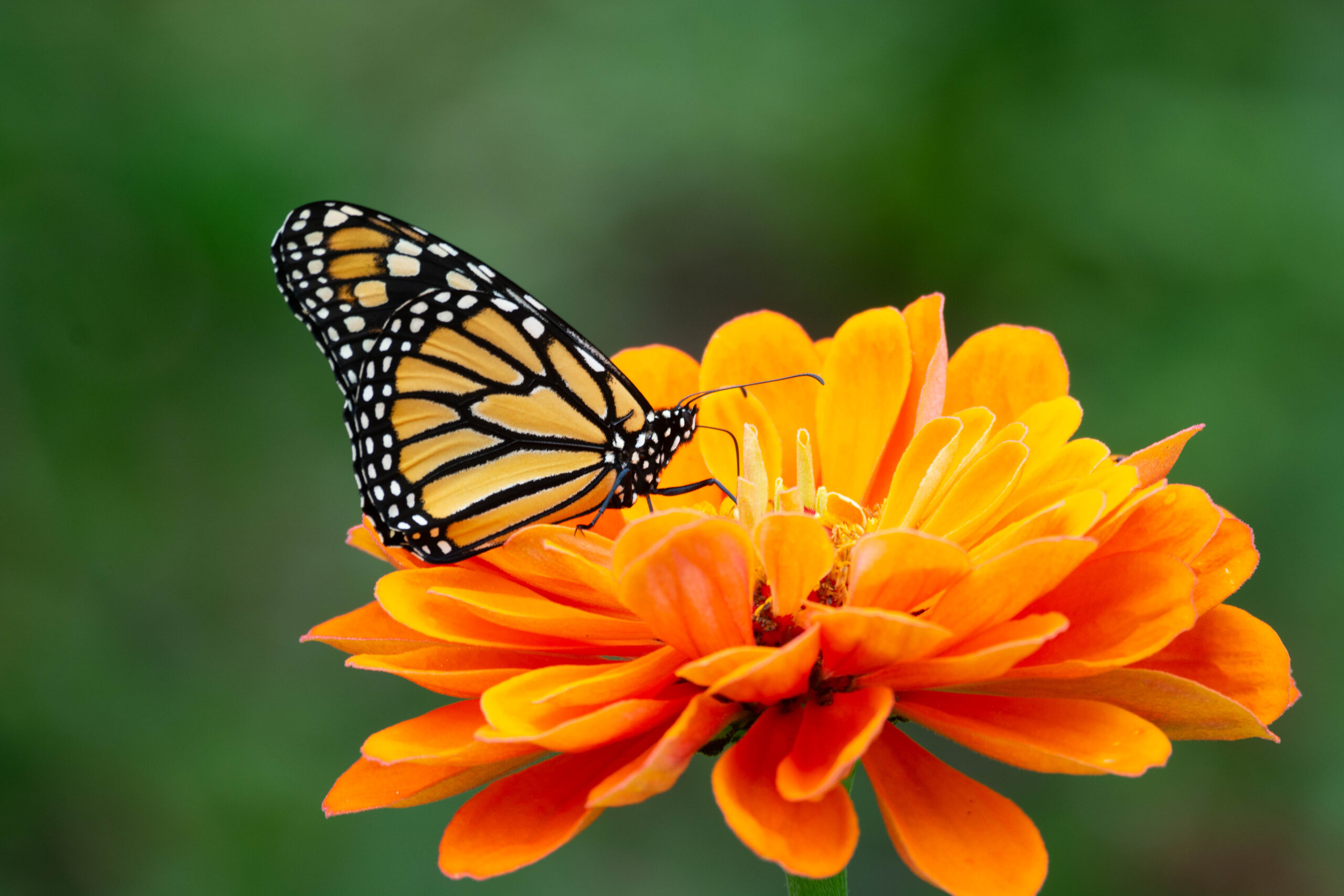
by Bill Gadbow
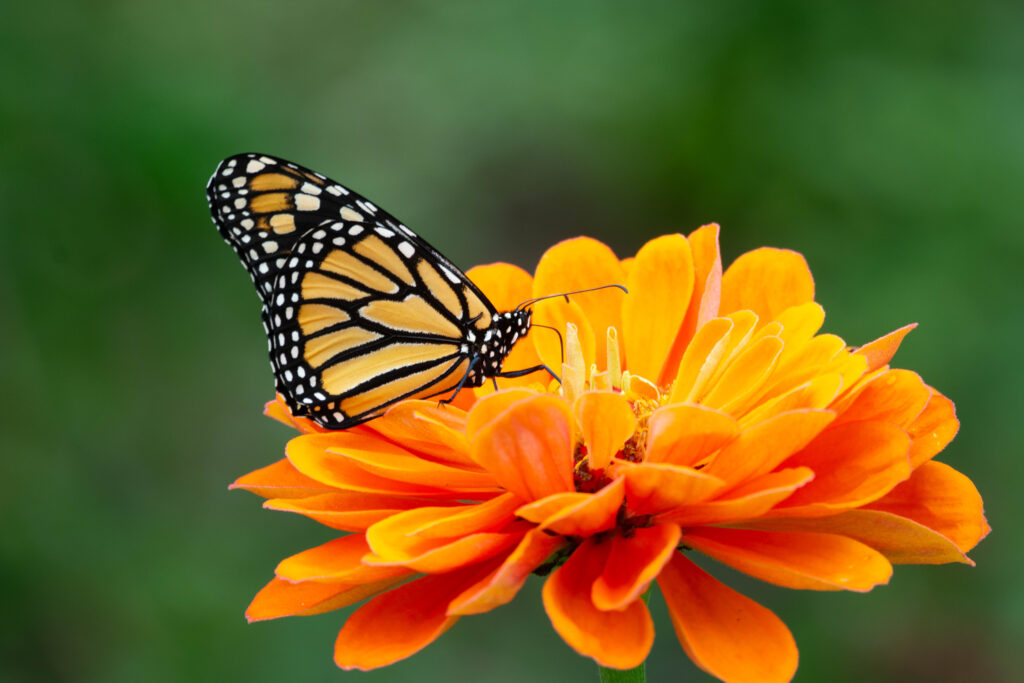
When we started selecting “pollinator” plants to add to the little garden around the birdfeeder that is watchable from our kitchen window, our intention was to help out Honeybees and Monarchs. We were aiming too low. We found out that there are lots more pollinators to consider.
Wasps, moths, and flies are also key pollinators. A class of insects called Hoverflies are champion pollinators and especially beneficial insects to attract to our gardens. Mosquitoes mostly drink nectar, not blood, which means they pollinate as they flit from flower to flower. Another key class of pollinators are beetles. There are lots more.
And the Honeybees aren’t even native to America. Colonists introduced Honeybees and now they are invasive. Native bees are the primary pollinators for many of our crops and gardens. There are approximately 400 native bee species in Pennsylvania. Some of the more common natives have nicknames – bumble bees, carpenter bees, squash bees, sweat bees – but most have no common names. Many of the native bees nest in the ground and most do not live in large social communities. If you look underneath the leaves in your pollinator garden early in the morning, you will find sleeping native bees who spent the night there. Putting up a bee house, which is basically just a collection of hollow stacked tubes, is a good way to help native bees find a good spot to lay their eggs.

I went back through my photo collection to look for the picture that I took of a Hummingbird Moth.
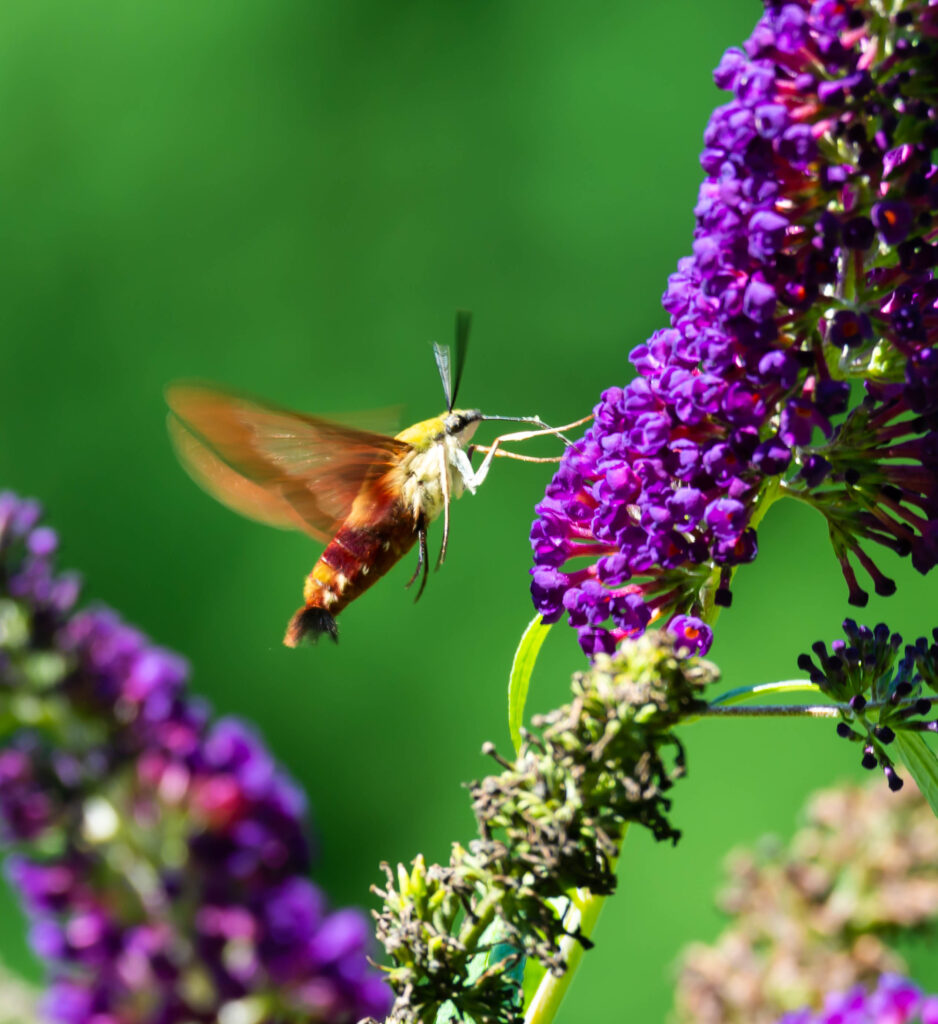
This is a very large insect, about a third the size of a real hummingbird, that looks, flies, and behaves like a hummingbird. Predators think that they are hummingbirds and leave them alone. They are great pollinators and not particularly uncommon, but they look so unusual that we often don’t register what they are. Was that a baby hummingbird that just flew by? It’s over there. Oh! Now it’s gone.
I found the pic. Guess what else I found. A few years back, I had been testing out my new fixed length lens to try my hand at macro photography. That’s when you take a picture of something tiny and blow it up thousands of times, still in focus, to see the intricate detail hidden in miniature. It turns out that there is a beautiful world of color hidden (to our eyes) in the insect kingdom. For example, the antenna of one insect looked black to the naked eye but were really green and white striped, not black at all. That day, I took about a hundred shots of a pretty purple insect who had lots of white spots. These turned out to be immature Spotted Lantern Flies. I deleted the photos and started squishing them instead. There was one photo that I kept of a small fly on a leaf. Here it is.
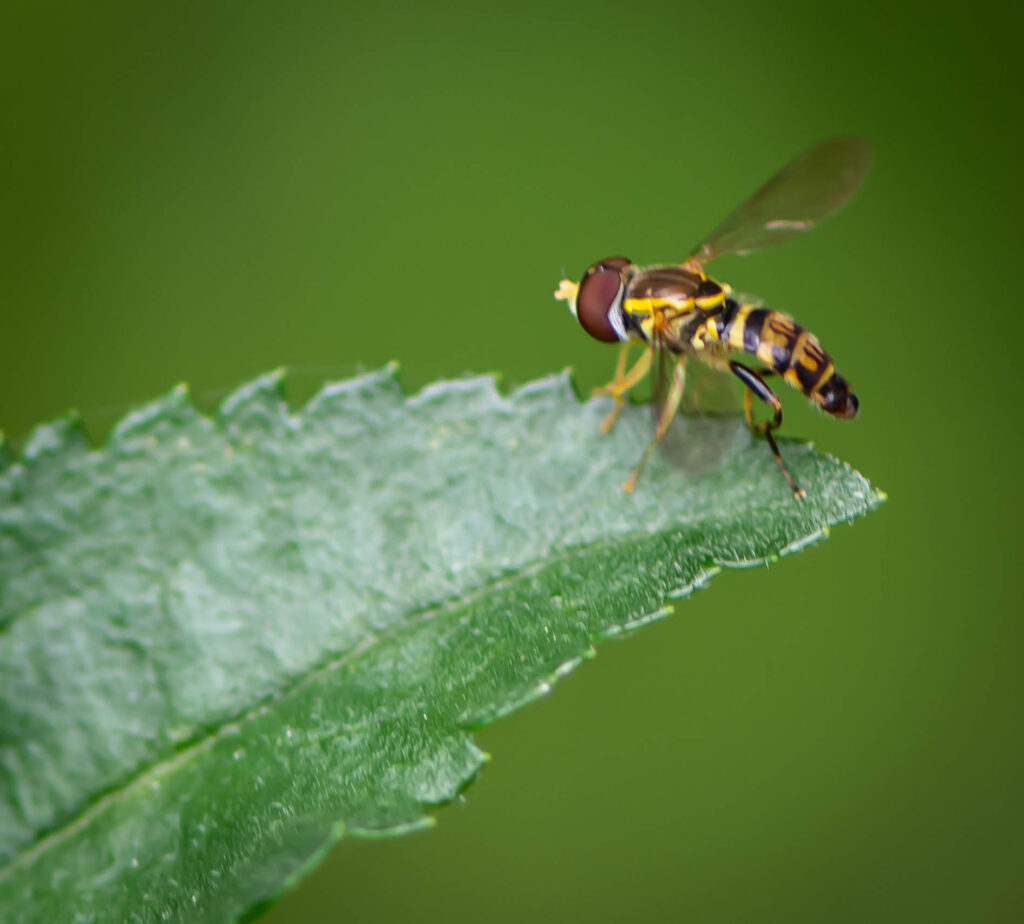
It’s a Hoverfly. So, we have those too, which is pretty nice!
Where a butterfly garden is designed to specifically attract butterflies, a pollinator garden will attract lots of different beneficial insects.
PLANT SELECTION
Native vs. non-native is a hot button issue. We weren’t particularly hung up on it, but that is changing. We planted mostly native plants and dug up scads of non-native weeds, but a few of our most beautiful flowers are non-native. When a beautyberry bush started growing in our garden, we hoped that the native variety had spread to our property, but we were more concerned about whether the bees liked the flowers and the birds liked the berries. They do, so the bush stayed and is doing nicely. If you are planting a pollinator garden, you will be planting a large proportion of native plants. I recently read an article by one of the scientists at Mount Cuba (Okay. I admit it. I’m shamelessly plugging an article about Mount Cuba that we are planning for the next issue of Birds Eat Free) that described their research into how specific insects have adapted to specific plants. If you desire to foster one of these insects, you need to plant its host plant. It may take a few seasons, but if you plant it, they will come.
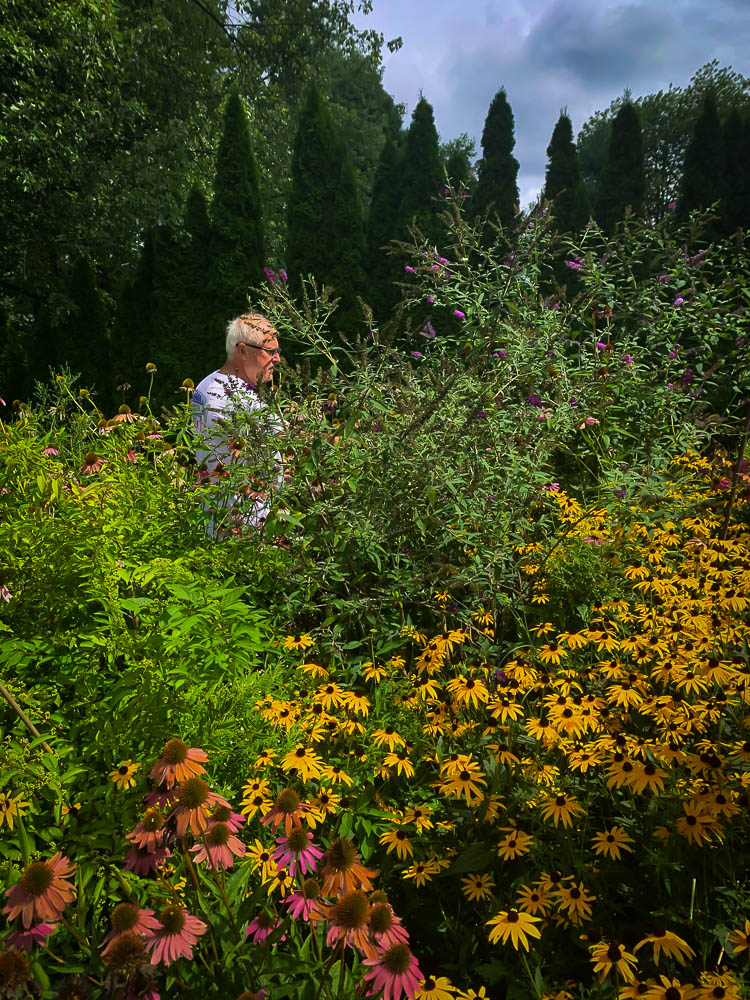
We are far from expert gardeners or naturalists. It is not a competition, and there is no purity test. A small batch of nice butterfly attracting plants in a corner of your yard, or a row of winterberry bushes, is a good thing. So go for it. The list of good plants to use is long, but here are some of the ones that we have tried and were able to grow in Chester County.
Good for butterflies: Butterfly Bushes (beware – non native), Purple Cone Flowers, Swamp Milkweed, Butterflyweed, Joe-Pye Weed, Zinnia, Beebalm, Sedum, Phlox, Liatris, Mint, Lavender, Daisy, Black-eyed Susan, Verbena, Salvia, and Aster
There are eleven varieties of native milkweed that grow in Pennsylvania. The three most common are Common Milkweed (Asclepias syriaca), Butterflyweed (Asclepias tuberosa) and Swamp Milkweed (Asclepias incarnata). All have the cardiac glycosides that the Monarchs need. Common Milkweed grows in fields in partial sun or full sun. Butterflyweed has beautiful orange flowers and likes moderate soil and full sun. Swamp Milkweed likes wetter soil. We started Butterflyweed from seeds four years ago and now we have lots of plants that are reseeding themselves and some plants that are three feet high and feeding Monarch caterpillars. We also bought Swamp Milkweed plants from a nursery, and we keep them pretty wet in the summer. The butterfly bush that is doing the best is out in the middle of the yard by itself in full sun.
Good for bees: Purple Cone Flowers, Hyssop, Russian Sage, Aster, Basil, Black-eyed Susan, Lavender, Thistle, Joe-Pye Weed, Sage, Allium (Ornamental Onion) and Zinnia.
Good for birds: Purple Cone Flowers (especially the Goldfinches love these) and Milkweed (which besides Monarchs attracts insects that the birds can eat), Dogwood trees, Winterberry bushes, and Viburnum (also a bush).
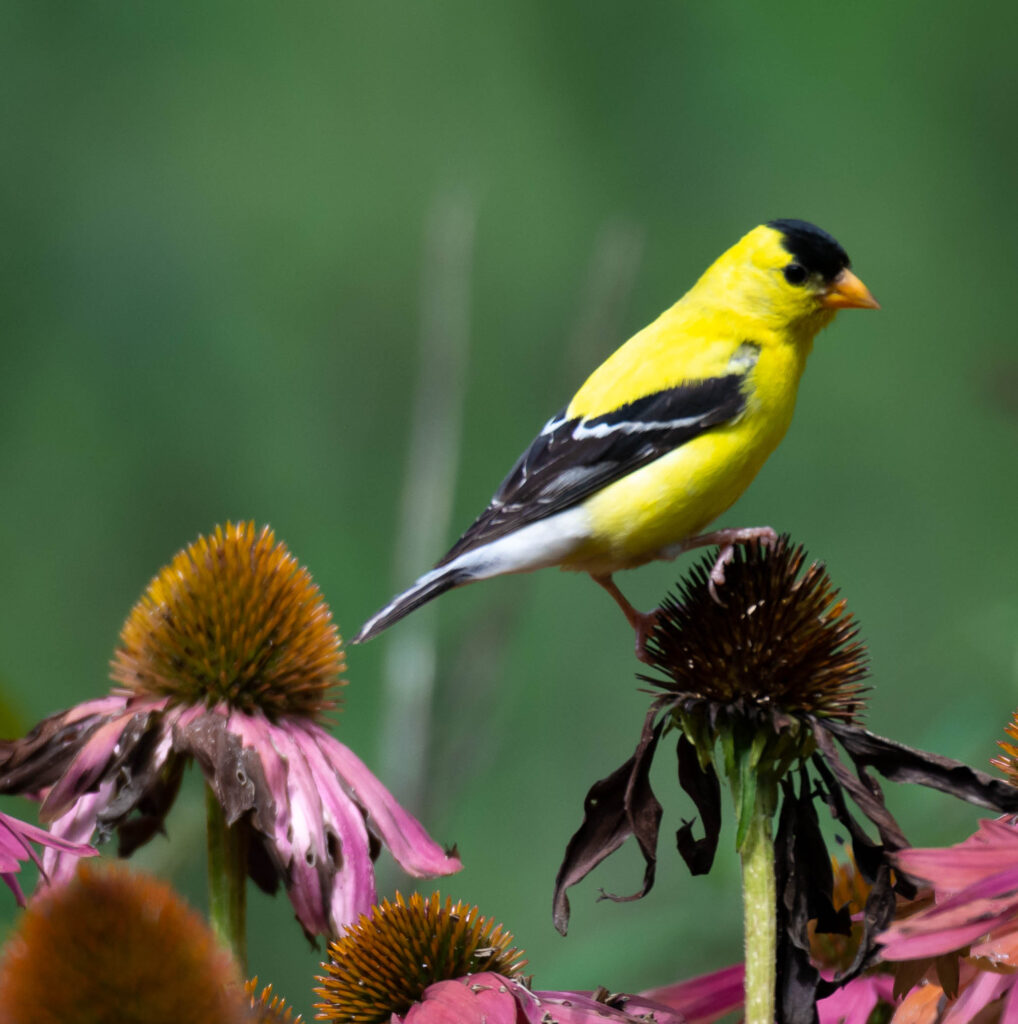
From summer, thru fall and winter, goldfinches eat the coneflower seeds. All through the winter months, a flock of Dark-eyed Juncos spend the day foraging in this one small garden.
WHAT IS A WEED?
A weed is a plant that is growing in a spot where you don’t want it to grow. Grass in your lawn is not a weed. Grass in the cracks in your driveway is a weed. You can think you are planting a desirable plant and after a while change your mind and decide that it is a weed. There are lots of examples, but one of the most dramatic is purple loosestrife. This beautiful ornamental plant was introduced to America in the 1800’s and started to crowd out cattails and other native plants from our wetlands in the 1900s. I need help here and hope that someone will post comments to complete this story. I remember reading that one of the lead government conservation officials led a large program to spread purple loosestrife to “foster biodiversity” in wetlands that were dominated by cattails. I tried to find the name of the official, but can’t find it now, and hope that one of you know the story. The result was huge landscapes of beautiful purple in my central New York State childhood home region, and throughout the U. S., which were ecologically dead, or at least diminished. Nothing would eat the loosestrife. Recently several beetle species have been safely introduced to help control this flower that became a weed.
You probably have your personal most hated invasive weeds, but mine are Crabgrass and Lesser Celandine. When I dug up a long rectangular slice of the back edge of my yard to make a garden about five years ago, a pretty yellow ground cover emerged from the bushes and spread throughout the upturned soil. I found out that it was the hated and hard to get rid of Lesser Celandine. I dug it all up and attacked the hardy plants living under the bushes. It took a week of back-breaking work. I bagged it up and had it all hauled away to a landfill. The next year it came back into the garden and now I had to dig it up while trying not to kill my new plants. That took another week. This year, finally, I don’t see any more of it in my yard. However, the crabgrass is killing me. I went away last summer for three weeks and during that time, the crabgrass completely took over sections of my backyard. Since it was too late to attack it with pre-emergent chemicals, and I don’t like to use the chemicals anyway, I dug it up and replanted grass. This year, I broke down and used pre-emergent crabgrass killer in the spring. I have less crabgrass, but still had to spend a number of wasted summer days getting rid of it. I hate the stuff.
So, in general, how do you get rid of weeds. The most common solution seems to be chemical control. I didn’t do that for most of my thirty-five years on my property, so my grass has more weeds than some of my neighbors. It also has more birds. Some of them are coming for the bird feeders, some for the food plants that we are growing, but often they are happy to poke around in the middle of the yard to find worms, insects, and seeds. Robins like my backyard. I have found that mowing a little bit higher helps keep weeds down and that pulling up the more obvious weeds helps. Three years ago, Chris pulled up all the dandelions and since then, we don’t have dandelions. When you absolutely have to use chemicals, I think there are some less toxic green options. Treating four times a year, with heavy doses of lawn chemicals, even when there are no weeds in your lawn, will definitely keep your lawn looking great. I get that. However, I think you can get close to that look and have a more natural living space by treating much, much less heavily and less often.
Another approach is to confine the pristine, no weeds portion of your lawn to a smaller area and leave the bulk of it to a more natural, but still nice, look.
Here is another thing that we do in our pollinator gardens. We don’t pull up everything in the fall. We leave most of the plants standing and get rid of the dead stuff that is still there in the spring. The plants are full of food for the winter birds, especially the purple cone flowers. We have a flock of ten to fifteen Dark-eyed Juncos that come every year to our yard in November and spend all day poking around on the ground in the garden closest to our house. It’s not a huge garden, but apparently there is enough food to keep that flock and other finches, sparrows, and bluebirds alive through the winter. Pulling up your plants in the fall would be like setting up a nice Thanksgiving dinner for your family and then taking it away before they got a chance to eat it.
UNWELCOME VISITORS

We get lots of Swallowtails and a decent number of Monarchs, plus lots of smaller butterflies that I don’t know the names of yet. Brown and orange with two big spots. Tiny and blue. Greenish-tinged white – I know those, Cabbage Leaf Butterflies. This Great Spangled Fritillary showed up one season, but not the next. He was a little smaller than the Monarchs and quite a bit outside his normal range. That’s okay. He was a welcome visitor.
We don’t feel the same way about deer. Deer can go through a bed of Day Lilies or a Hosta garden and munch all the good stuff in a night. Techniques to repel deer are bad smelling chemicals that wash off in the rain and need to be reapplied, screens which are expensive and don’t really look that good, and fences that are at least eight feet high. A deer will hop a four-foot fence like it isn’t there and can do a six-foot fence if it wants to. Rabbits also like to munch their way through our gardens. Certain insect pests can quickly strip your plants. Another less frequent, but still admirable for his persistence, invader is the woodchuck, a. k. a. groundhog.
My neighbors and I have been battling deer for years. Eventually the deer win. I was with my dad the morning after a deer had eaten every rose blossom in his extensive garden. He was upset. We’ve woken up multiple years to find crops of beautiful yellow Day Lily blossoms missing from their stalks. We’ve had some success with screens, and planting Marigolds with their strong scents seems to help for a while, but actually the best approach is to select deer and rabbit resistant plants. These include some of our favorites. Purple Cone Flower, Beebalm, Catmint, Mint, Alyssum, onion family flowers, Hyssop, Bleeding Heart, Columbine, and Black-eyed Susan are some of the deer resistant pollinator plants.
We don’t spray for pest bugs. Chris and I pick them off when we see them as we walk along the gardens. I drop them in a bottle with a little bit of gas or water in the bottom. Chris just squishes them. We sometimes get Japanese Beetles and also Milkweed bugs. The Milkweed Bugs don’t really do any harm, except that they eat the milkweed. To get rid of them, I put a quarter inch of gasoline in a wide moth container with a lid. The plastic containers that the grocery store deli counters use are perfect. Then I just put the container under the leaf and knock the bugs into the gas. The physical extraction seems to work very well and each year we get less of the harmful insects and more of the ones that we like.
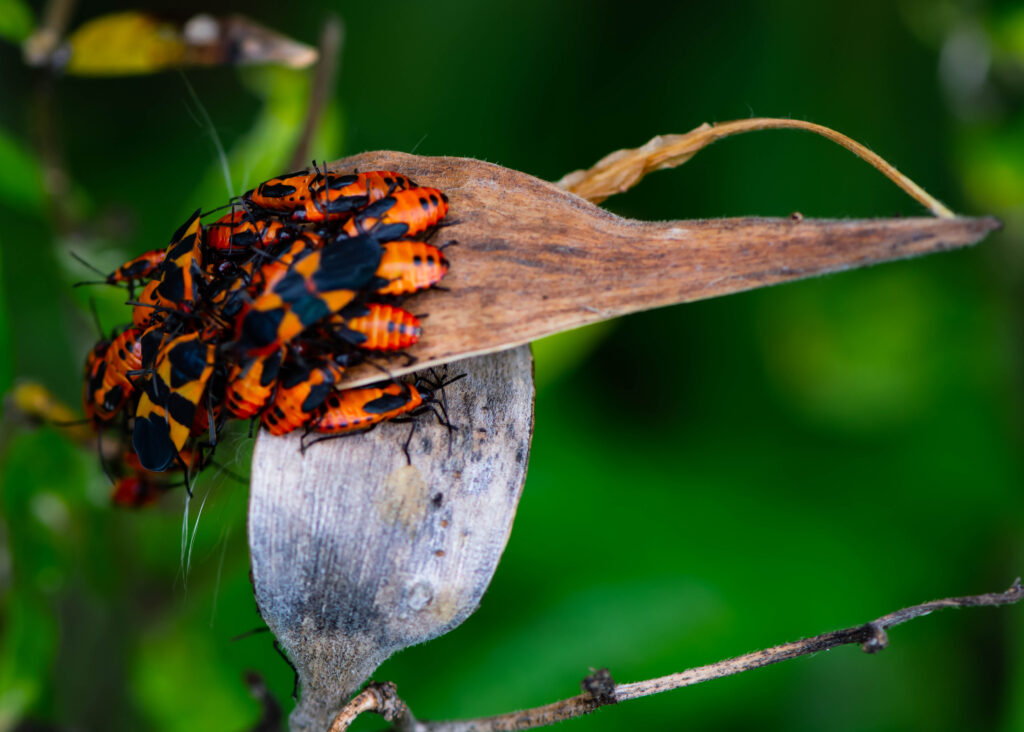
When we were growing vegetables, we had a woodchuck. We trapped him in a Have-A-Heart trap and let him go in the woods of The Marsh Creek State Park. In most states woodchucks are protected animals. It’s legal to trap woodchucks in Pennsylvania, but you need permission from a landowner to release it on the landowner’s property.
WHY MILKWEED?
All parts of the milkweed plant contain a poison called galitoxin, a type of cardenolide or cardiac glycoside. The most severe cases of toxicity involve cardiac symptoms, like arrhythmias, and can lead to a heart attack. There are also lesser, but still serious symptoms. Usual victims are horses, cattle, and sheep. We have a decent amount of milkweed in our backyard and our dog ignores it. Digoxin is another cardenolide and it is found in Foxtail. Foxtail is pretty and great for pollinators, but we don’t use it because of our dog.
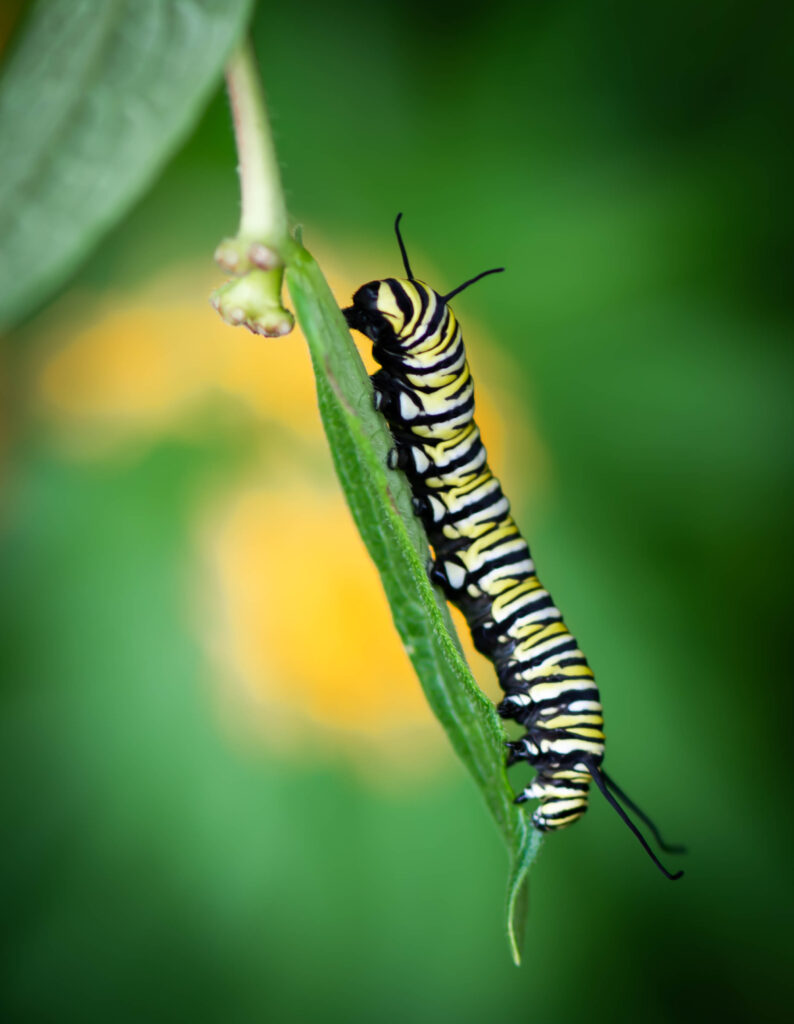
Monarchs are resistant to the toxin and caterpillars eat the milkweed leaves. In fact, they only eat milkweed and will not harm your other garden plants (like tomatoes). The toxin builds up in the caterpillar bodies and remains in the adults, so birds and predator insects leave Monarchs alone. They have learned that eating them not only tastes bad but makes them sick. The bright orange color is a well-recognized warning signal in nature. It announces, “I am so toxic that you would be crazy to eat me. I am so toxic that I don’t need protective coloration to hide.”
There is another butterfly, the Viceroy, who doesn’t eat milkweed and isn’t poisonous, but it looks almost exactly like the adult Monarch butterfly. Viceroys are a little smaller and have an additional horizontal black line across their wings. It is really hard to tell the two species apart and predators leave them both alone.
SYMBIOSIS VS. PREDATOR/PREY
Obviously, we are fans of symbiosis. That’s what pollination is all about. Two separate organisms have a mutually beneficial relationship. In pollination, the pollinator gets food and the pollinated gets their sex cells spread across different individuals of their species. It’s a win / win. What could be better?
Consider the Predator / Prey relationship. Here one species, the predator, gets a meal and the other species winds up eaten. Not mutually beneficial. You might expect that this kind of relationship would be undesirable, especially when compared to everybody wins symbiosis. So why is predator / prey so widespread?
Think about how it works. For an example, let’s talk about foxes and rabbits. When conditions are good for rabbits, their numbers increase. The increase in rabbits is good for foxes, so the foxes increase. The increase in foxes causes a lot of rabbits to get eaten, which starts to drive rabbit numbers down. Next season there are more foxes than the rabbit population can support, so the fox numbers start to drop. This is called a negative feed back loop and it tends to drive a system to equilibrium.
For symbiosis, the opposite happens. For an example, let’s stick with Monarch butterflies. The more Monarchs, the better for milkweed. The more milkweed, the better for the Monarchs. That sounds pretty good, unless the numbers get absolutely out of control. But, remember that the opposite is also true; less Monarchs means less of its specifically adapted pollinated plant and less milkweed means less pollinators. If something bad happens to either of the pair in the symbiotic relationship, that will drive the numbers down for the second symbiont, which then further drives down the numbers of the already stressed species. This is a called a positive feedback loop and it is inherently unstable because it drives the system away from equilibrium.
An unhealthy positive feedback loop is happening right now with Monarchs and milkweed. We aren’t sure what the initial bad thing is that caused the crisis – a likely theory is habitat destruction in the Monarch wintering grounds in Mexico – but the nature of the relationship means that even if we can fix the initial cause of the crisis, the numbers of both species will take much longer to recover.
NEXT EPISODE
In our next issue of Birds Eat Free, we will have an article completely about non-natives, featuring The Mount Cuba Center in Hockessin, Delaware. Please add comments to the article. We want the website to be interactive, so that we can all learn from each other and share our news and photos.